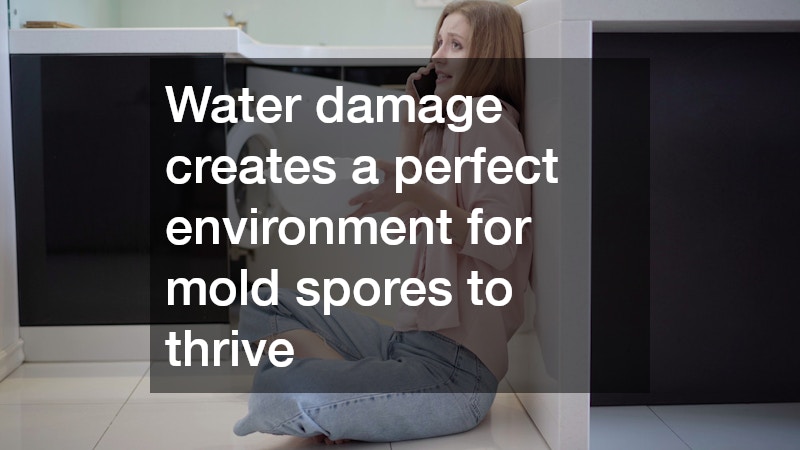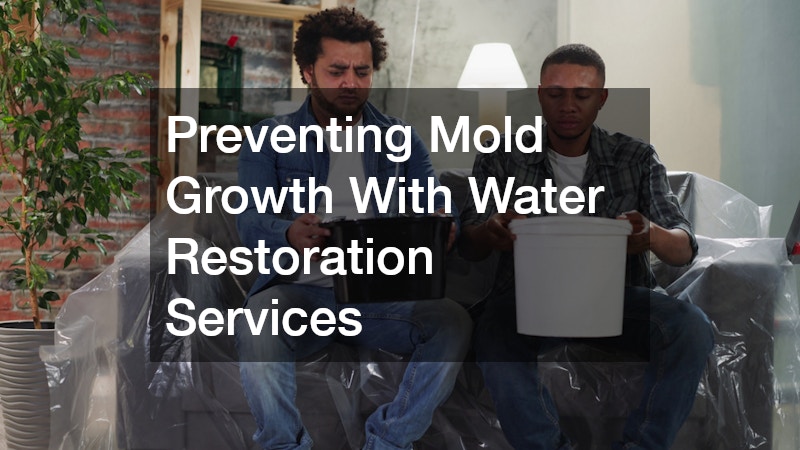Water restoration services are integral for helping homeowners prevent mold growth after a flood. Learn the answers to common questions and concerns regarding water damage in your home.
What Are Water Restoration Services?
Water restoration services encompass a variety of processes aimed at addressing water damage in residential and commercial properties. These services typically include water extraction, drying, dehumidification, and repair of affected areas.
The goal is to return the property to its pre-loss condition as swiftly as possible. From flooded basements to burst pipes, the range of potential water damage scenarios demands a comprehensive and tailored approach.
The water restoration process begins with a thorough assessment of the affected areas to determine the extent of the damage. Professionals utilize advanced equipment such as moisture meters and infrared cameras to identify hidden moisture, which would otherwise promote mold growth. Following the assessment, the actual restoration work, which could involve pumping out water and drying materials, commences. Proper techniques and rapid action are critical to minimizing the potential for mold development.
Water restoration services also provide preventive measures against future issues. After the cleanup is complete, experts often advise on techniques to enhance moisture control and tackle related concerns. This may include suggestions for improving drainage around the property or installing sump pumps. Effective water restoration not only addresses the immediate hazards but also fortifies the premises against similar incidents in the future.
How Can Water Damage Lead to Mold Growth?
Water damage creates a perfect environment for mold spores to thrive. Mold typically requires moisture, warmth, and organic material, all of which can be found in water-damaged areas. Once water infiltrates materials like wood, drywall, or carpeting, these surfaces become a breeding ground for mold growth. The damp conditions, if not addressed in a timely manner, can lead to extensive contaminant proliferation.
The timeline of mold growth can be alarmingly short. Within as little as 24 to 48 hours following water damage, mold can begin to develop. This rapid growth underscores the need for immediate action during water restoration. Mold can not only deteriorate the structural integrity of a property but can also pose serious health risks to occupants. Prolonged exposure to mold can lead to respiratory issues, allergies, and other health complications.
Moreover, different types of mold can produce various toxins that aerate in the indoor environment. Some molds can release mycotoxins, which can affect the nervous system, leading homeowners to experience a range of symptoms without realizing the underlying cause. Creating an environment that is inhospitable to mold is essential, emphasizing how critical it is to respond effectively to water damage before it results in a serious mold infestation.
What Should You Do Immediately After Water Damage?
After experiencing water damage, the first step homeowners should take is to identify the source of the water and stop it if possible. Whether it’s a burst pipe, a roof leak, or floodwaters, addressing the root cause is essential to prevent further damage. Once the source is contained, remove any standing water using a wet vacuum or mop. The quicker these steps are taken, the better the chances are of preventing mold growth.
Next, it’s crucial to air out the affected areas. Open windows and doors to promote ventilation and use fans to circulate air. This not only helps in the drying process but also significantly decreases humidity levels, which mold thrives in. Allowing fresh air into the space creates an environment less conducive to mold development, further increasing the effectiveness of water restoration efforts.
Lastly, removing saturated materials like carpets, upholstery, or insulation that cannot be dried can significantly reduce the risk of mold. While some items may be salvageable, others pose a direct threat if maintained in their damp state. Disinfecting all surfaces that have come into contact with water is also vital. By following these immediate actions, homeowners greatly reduce potential mold risks and start the recovery process on a positive note.
How Do Professionals Prevent Mold Growth During Restoration?
Professional water restoration experts employ various techniques to prevent mold growth during restoration. One primary method involves the use of specialized equipment such as industrial-strength dehumidifiers and air movers. These tools are designed to effectively lower humidity levels and expedite the drying of affected areas and materials, inhibiting mold’s ability to establish itself.
Moreover, professionals often apply antimicrobial treatments to surfaces that have been exposed to water. These solutions are specifically formulated to eliminate mold spores and prevent regrowth. By targeting areas where mold could potentially thrive, restoration professionals ensure that the property remains safe and habitable once initial cleanup is complete. Such interventions are crucial in significantly reducing future mold risks.
Furthermore, restoration services also include monitoring the drying process closely. Experts continuously check moisture levels using advanced tools, adjusting their methods as needed to ensure optimal drying. By maintaining a controlled environment and implementing preventive measures, professionals can reduce the chances of mold taking hold in the aftermath of water damage. Their expertise and precise techniques play a vital role in safeguarding properties from mold infestations that could emerge following water restoration.
When Should You Seek Professional Water Restoration Services?
Homeowners should seek professional water restoration services immediately once they detect water damage, regardless of the apparent extent. Even small amounts of water can lead to mold if not treated properly and in a timely manner. If the affected area exceeds a certain size (typically around 10 square feet) or involves materials difficult to dry, it’s prudent to consult professionals. Their expertise can make a significant difference in outcomes.
Additionally, if homeowners notice an unusual odor or visible mold growth, it’s a definitive sign that mold is present or starting to develop. The presence of mold, even in small patches, can have serious health implications. In such cases, professional help is not only advisable but necessary to assess and eliminate the threat efficiently.
If the source of water damage is unsure or the situation seems overwhelming, it’s best to err on the side of caution and seek expert services. Professionals not only have the right tools and knowledge to restore and mitigate water damage effectively, but they can also provide peace of mind. Early intervention through professional services can avoid long-term consequences related to mold growth and property damage.
Timely intervention and professional water restoration services are essential in preventing mold growth and maintaining a healthy indoor environment. Taking immediate steps post-water damage, utilizing the services of professionals, and understanding the risks associated with mold can help safeguard not just the property but the health and well-being of its occupants. Recognizing the importance of professional assistance ensures that water-related issues are resolved before they escalate, contributing to safer living conditions.

